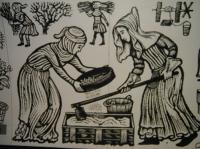23 Feb 2006
Clay Plastering in Charing Cross Tube Station
 I was up in London over the last couple of days (hence the lack of posts…) to attend the **EcoBuild** conference (I’ll tell you more about that tomorrow) where I was to give a talk. On my way there I passed through Charing Cross underground station, which is decorated with beautiful floor to ceiling panels of old woodcuts showing medieval folks building houses. It shows people gathering coppice timber and building stone walls, but my natural builder’s eye was drawn to one that showed people preparing clay plasters.
I was up in London over the last couple of days (hence the lack of posts…) to attend the **EcoBuild** conference (I’ll tell you more about that tomorrow) where I was to give a talk. On my way there I passed through Charing Cross underground station, which is decorated with beautiful floor to ceiling panels of old woodcuts showing medieval folks building houses. It shows people gathering coppice timber and building stone walls, but my natural builder’s eye was drawn to one that showed people preparing clay plasters.
That looks very familiar I thought, and was cast back to the first clay plastering I ever did, on the strawbale house built in the grounds of Kinsale FEC, where armed only with a copy of Keely Meegan’s Earth Plasters for Strawbale Homes we set to plastering the inside of the house with our own handmade clay plasters. We mixed them in exactly the way shown in the woodcut, and they went on lovely. I have since refined my techniques, learning from Linda Smiley of Cob Cottage Company, becoming familiar with additives such as flour paste, and coming to deeply love this material.
 I always liken clay plastering to giving someone a massage with oils, because they set so slowly they are deeply sensual, you can keep going back over them and they are quite hard to leave alone! The first few times I made them I did them as appears in the woodcut, except I used a wheelbarrow, rather than whatever the rectangular thing is that they are using here. Subsequently, when preparing the plasters for my late cob house, I used a cement mixer, which while being a useless way to mix cob, makes great clay plasters.
I always liken clay plastering to giving someone a massage with oils, because they set so slowly they are deeply sensual, you can keep going back over them and they are quite hard to leave alone! The first few times I made them I did them as appears in the woodcut, except I used a wheelbarrow, rather than whatever the rectangular thing is that they are using here. Subsequently, when preparing the plasters for my late cob house, I used a cement mixer, which while being a useless way to mix cob, makes great clay plasters.
Here is the recipe that I used to plaster my house, bearing in mind the fact that every site’s subsoil is different, and the best way to perfect your plasters is to make a range of test mixes and see which perform the best.
 **Clay Plaster – The Hollies recipe…**
**Clay Plaster – The Hollies recipe…**
6 parts sand, clean with no stones in
1 part clay slip (pure clay mixed with water to the texture of runny yoghurt)
½ part shredded clay straw (dry clean straw, chopped in a barrel using a strimmer and then rubbed through a ¼